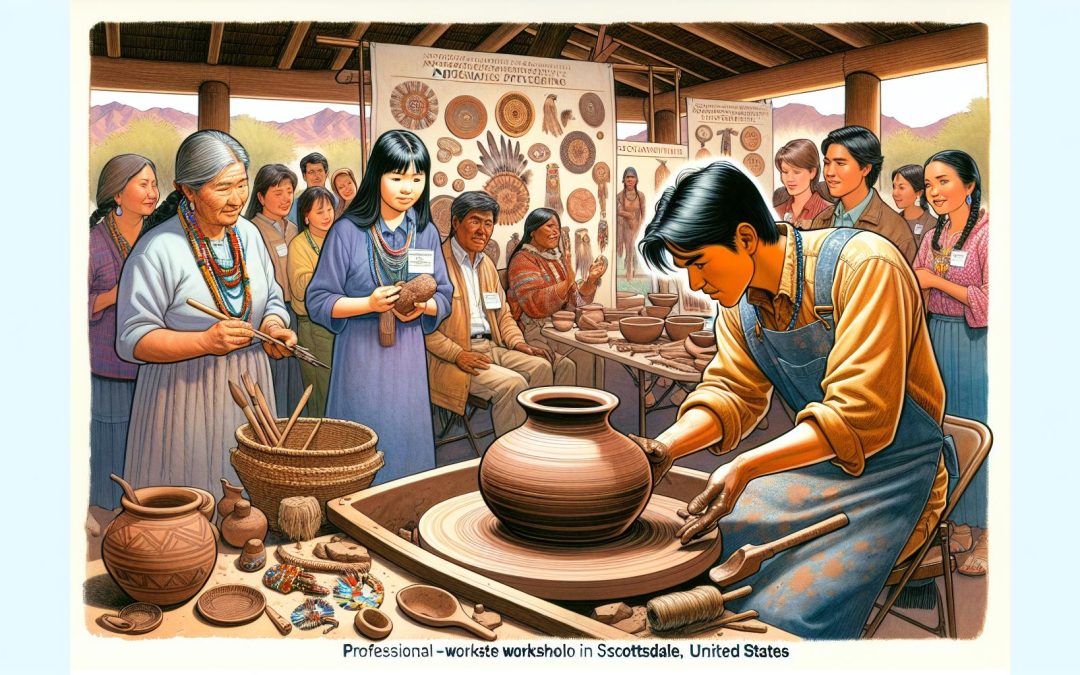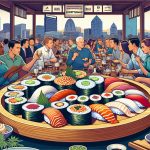I’ve always been fascinated by the rich tapestry of culture and history that traditional Indigenous art represents. It’s not just about the vibrant colors or the intricate patterns; it’s a profound way of connecting with the past and understanding the stories and traditions that have shaped communities for centuries. That’s why I was thrilled to discover a series of traditional Indigenous art workshops right here in Scottsdale.
These workshops aren’t just art classes; they’re immersive experiences that invite participants to dive deep into the world of Indigenous artistry. Led by skilled artisans who are keepers of their cultural heritage, each session is a journey through time and creativity. Whether you’re a seasoned artist or someone who can barely draw a stick figure, there’s something incredibly special about holding a brush and being guided by the wisdom of generations.
Join me as I explore what makes these workshops a must-visit for anyone looking to experience the beauty and depth of Indigenous art firsthand.
The Heart of Traditional Indigenous Art Workshops in Scottsdale
Exploring the heart of traditional Indigenous art workshops in Scottsdale, I’ve discovered a vibrant ecosystem of creativity and culture. These workshops, nestled in a city known for its rich art scene, stand out as sanctuaries of Indigenous craftsmanship and centuries-old traditions. At their core, they’re not just about learning techniques; they’re about connecting deeply with Indigenous cultures, understanding their narratives, and expressing this connection through art.
At the forefront, skilled artisans, who carry the knowledge and stories of their ancestors, lead these workshops. They offer a diverse range of experiences, from pottery making, inspired by the ancient designs of the Anasazi, to weaving, reflecting the intricate patterns passed down through Navajo traditions. Participants, regardless of their artistic background, dive into a hands-on journey, immersing themselves in the creation process. It’s an experience that’s as educational as it is therapeutic.
The locations of these workshops often add another layer to the learning experience. Many are set in places surrounded by the natural beauty of Scottsdale, from desert landscapes to serene sunsets, providing a backdrop that inspires creativity and a deeper connection to the earth, mirroring the Indigenous relationship with land. This setting not only fuels inspiration but also serves as a gentle reminder of the importance of nature in Indigenous cultures.
Beyond the artmaking, these workshops foster a sense of community. They bring together people from various backgrounds, all seeking to learn and express appreciation for Indigenous cultures. It’s a place where conversations flow freely, stories are shared, and friendships are formed. This communal aspect highlights the workshops’ role in promoting cultural understanding and respect, aligning perfectly with my aspiration to connect with and learn from Indigenous wisdom.
In essence, the traditional Indigenous art workshops in Scottsdale offer more than just an opportunity to learn about Indigenous art; they provide a gateway to understanding the soul of Indigenous cultures and the stories they hold. It’s an enriching experience I eagerly anticipate diving into, and I invite others to join in discovering the beauty and wisdom embedded in Indigenous artistry.
Experience the Richness Through Art Forms

Exploring traditional Indigenous art workshops in Scottsdale, I’ve discovered the variety of art forms that embody the richness of Indigenous culture. These art forms not only captivate with their beauty but also tell stories of a profound connection to the Earth and the Indigenous way of life. Here’s a closer look at some of these art forms participants can immerse themselves in.
Pottery Making
Pottery making stands as a mesmerizing experience where clay transforms into a vessel of cultural expression. Guided by artisans who’ve inherited centuries-old techniques, I learned about the significance of designs and the importance of each step in the pottery-making process. The hands-on approach provided a deep sense of connection to the Earth, mirroring the Indigenous relationship with the land.
Weaving
Participating in weaving workshops, I was introduced to an art form integral to Indigenous culture. Using natural fibers, the process requires patience and precision, qualities that are highly revered. I was fascinated by how patterns and colors weave together to tell stories or represent important aspects of Indigenous life. It’s an engaging way to understand cultural values and the meticulous artistry involved in traditional weaving.
Jewelry Making
Jewelry making is another vibrant aspect of Indigenous art that I explored. Using materials like turquoise, silver, and other natural elements, these workshops offered insights into the symbolism behind each piece. The intricate designs and crafting techniques passed down through generations highlight the deep-rooted artistic vision and cultural identity inherent in Indigenous jewelry.
Storytelling
Beyond visual arts, storytelling workshops provided an auditory immersion into Indigenous cultures. Storytelling is a powerful tool for education and preserving heritage, and participating in these sessions, I gained a deeper appreciation for the oral traditions that have been kept alive through generations. It was an incredible opportunity to listen to tales that encapsulate the values, beliefs, and experiences of Indigenous peoples.
Indigenous art workshops in Scottsdale offer a unique blend of historical depth, cultural significance, and personal creative exploration. Whether it’s shaping clay, interlacing fibers, crafting symbolic jewelry, or delving into the art of storytelling, each form invites participants to experience the richness of Indigenous cultures. This journey through diverse art forms provides a pathway to understanding, appreciating, and connecting with the enduring legacy and wisdom of Indigenous peoples.
Notable Artists and Their Impact

Following the exploration of traditional Indigenous art workshops in Scottsdale, it’s crucial to shine a light on the notable artists who bring these experiences to life. Their work not only enriches the workshops but also leaves a lasting impact on attendees, fostering a deeper appreciation for Indigenous culture.
- Raye Dorame, Pottery Maestro: Raye has revolutionized pottery workshops by integrating ancient techniques with contemporary design. Her creations, inspired by her Indigenous heritage, offer participants a hands-on experience that goes beyond just crafting pottery. They learn the cultural significance behind each design, making every piece truly unique.
- Elena Hightower, Weaving Wizard: In the world of weaving, Elena stands out for her intricate patterns that tell stories of her Indigenous roots. Through her workshops, I’ve seen participants become mesmerized by the loom, as they weave threads into tangible connections with the earth and its histories.
- Carlos Silverhawk, Jewelry Genius: Carlos’s expertise in traditional jewelry making, particularly in turquoise and silver, transforms his workshops into treasure troves of cultural learning. His meticulous attention to detail and passion for storytelling through jewelry inspire attendees to create pieces that carry profound cultural narratives.
- Mia Blackbird, Storyteller Supreme: Mia brings Indigenous storytelling to life, connecting workshop participants to ancestral wisdom through captivating tales. Her storytelling sessions are not just a learning experience but a heartwarming journey into the past, making ancient traditions relevant today.
Each artist contributes immensely to Scottsdale’s Indigenous art workshops, creating experiences that are not just educational but deeply transformative. Their dedication to sharing their knowledge and skills ensures that the richness of Indigenous culture continues to thrive, encouraging others to explore and appreciate this invaluable heritage. Through their work, they’ve proven that art is a powerful medium for cultural expression and preservation, making a significant impact on everyone who participates in these workshops.
How to Participate in Workshops
Participating in traditional Indigenous art workshops in Scottsdale is a rejuvenating experience. It’s not just about learning new skills but also about immersing oneself in the rich cultural heritage these workshops offer. Here’s how I’ve found you can get involved in these incredible workshops:
- Research and Select a Workshop: Start by researching the specific type of art form you’re interested in. Whether it’s pottery making with Raye Dorame, weaving with Elena Hightower, jewelry making with Carlos Silverhawk, or storytelling with Mia Blackbird, each artisan brings a unique blend of skills and cultural knowledge.
- Contact the Workshop Organizers: Once you’ve identified a workshop, the next step is to reach out to the organizers. They often have websites or social media pages where you can find contact information. Additionally, cultural centers in Scottsdale frequently host these workshops and can provide schedules and availability.
- Register Early: These workshops tend to fill up quickly, thanks to their popularity and the limited spots available. It ensures participants get ample direct interaction with the artisans. Therefore, I recommend registering as early as possible to secure your spot.
- Prepare for the Workshop: After registration, you’ll likely receive information on what to expect, including any items you should bring. Embrace this opportunity to learn and connect, and remember, no prior experience is usually required. The artisans are there to guide you through every step, making it a welcoming environment for beginners and advanced participants alike.
- Engage and Ask Questions: During the workshop, engage fully with the experience. Asking questions not only enriches your own understanding but also shows respect and appreciation for the artisans’ expertise and cultural heritage. It’s a chance to dive deeper into the meanings behind the art and the stories they encapsulate.
By following these steps, I’ve managed to participate in several workshops, each time leaving with a deeper appreciation for Indigenous cultures and the beautiful art they produce. It’s truly a unique way to engage with and support Indigenous artistry and traditions.
The Benefits of Engaging with Indigenous Art
Engaging with Indigenous art through workshops like those I’ve mentioned in Scottsdale provides profound benefits that extend well beyond the creation of a tangible object. This immersive experience not only allows participants to learn about Indigenous cultures but also to connect with them on a much deeper level. By diving into art forms like pottery making, weaving, jewelry making, and storytelling, individuals gain a unique perspective that enriches their understanding and appreciation for these ancient practices.
Firstly, participating in Indigenous art workshops fosters cultural appreciation and sensitivity. By working directly with artists such as Raye Dorame, Elena Hightower, Carlos Silverhawk, and Mia Blackbird, attendees are immersed in the stories and traditions that underpin each art form. This direct interaction facilitates a genuine respect for the culture and traditions of Indigenous people, promoting cultural preservation.
Additionally, these workshops serve as a bridge to connect with the Earth and Indigenous traditions. Artisans emphasize the significance of using natural materials, which promotes environmental awareness among participants. For example, pottery and jewelry-making classes often use clay, stones, and metals sourced directly from the Earth, highlighting the importance of sustainable practices and the deep connection Indigenous cultures maintain with the environment.
Moreover, engaging in these art forms enhances creative expression and personal wellness. The meticulous artistry required in traditional Indigenous crafts helps improve focus, patience, and hand-eye coordination. Furthermore, the storytelling aspect of these workshops enriches the creative experience, offering insight into narrative techniques and the cultural significance behind each piece.
Finally, by participating in these workshops, individuals support Indigenous artistry and communities directly. Attendance and engagement not only provide financial support but also help sustain the interest in and transmission of these art forms to future generations. It’s a meaningful way to contribute to the preservation of Indigenous cultures and their artistic legacy.
Engaging with Indigenous art workshops in Scottsdale offers numerous benefits, from fostering cultural appreciation and environmental awareness to enhancing personal wellness and supporting Indigenous communities. It’s a richly rewarding experience that connects participants to the history, traditions, and artistic expressions of Indigenous peoples.
Conclusion
Diving into traditional Indigenous art workshops in Scottsdale has opened my eyes to the rich tapestry of cultures and traditions right at our doorstep. It’s not just about learning a new skill or creating something beautiful with my hands. It’s about connecting on a deeper level with the stories, the people, and the land that these arts come from. I’ve found a newfound appreciation for the dedication of artists like Raye, Elena, Carlos, and Mia who are not just preserving their heritage but sharing it with open hearts. Supporting these workshops means we’re all playing a part in keeping these precious traditions alive and thriving for generations to come. I can’t wait to see what other treasures I’ll discover in my next workshop.







